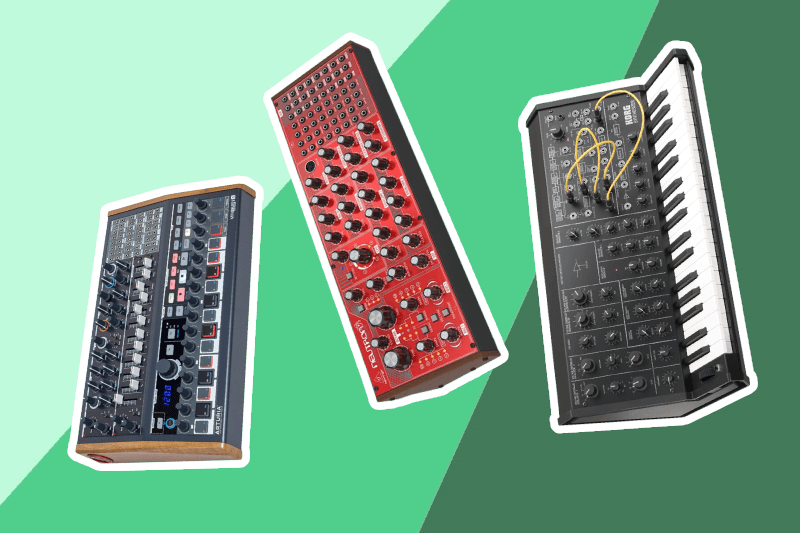
Despite modular synthesis being a niche market, many options confront a novice synthesist. Most manufacturers make a broad range of modules, coupled with auxiliary equipment needed to power and house them. Thus, settling for a reputable manufacturer is not the end. You still have to choose the best modular synths from a range of a brand's collections.
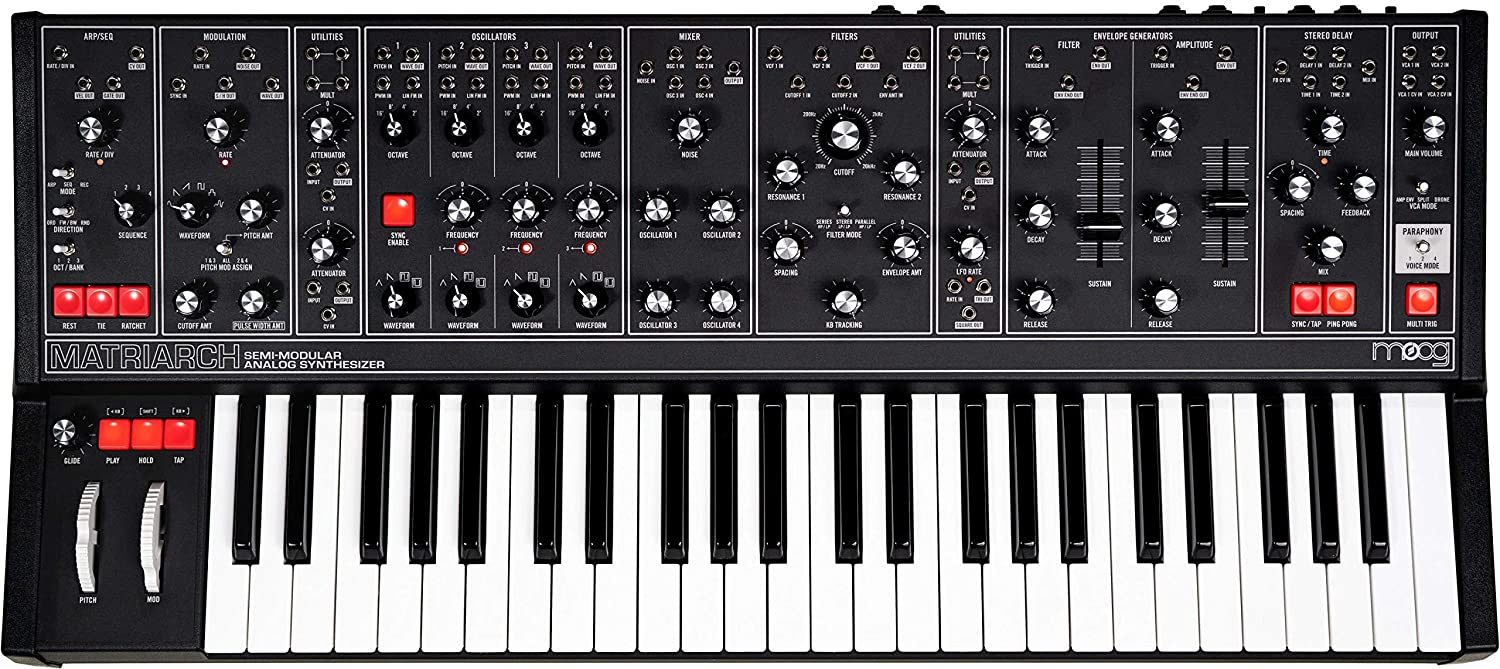

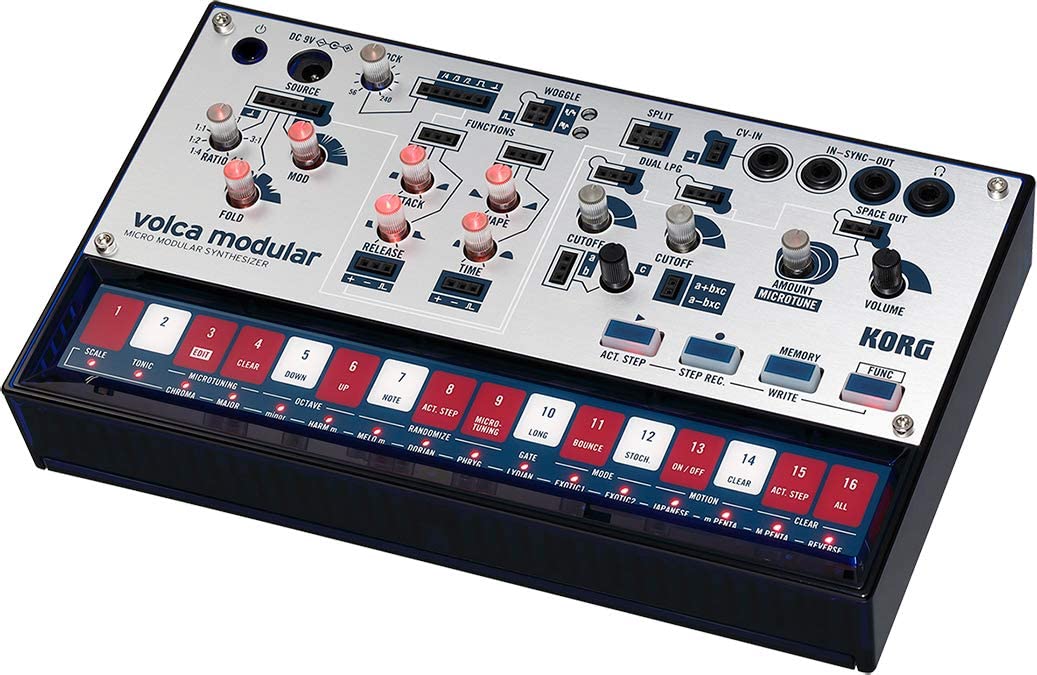

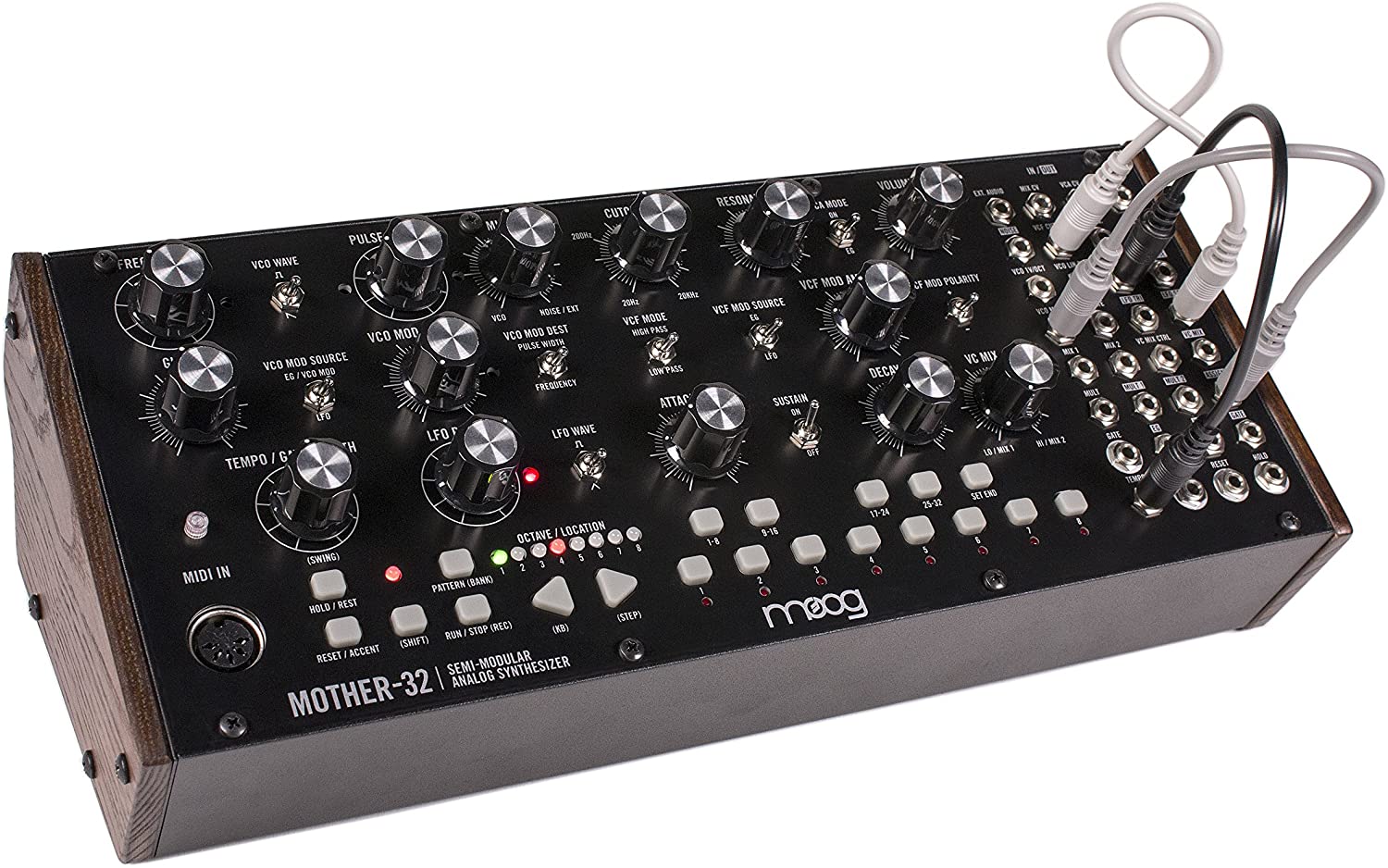

Ultimately, you want a collection of modules or a device that’s both self-contained and usable by itself. That means a collection of modules presented as a complete solution or a semi-modular synthesizer (In which case, some parameters are preset). Regardless of choice, your device should be patchable into a larger modular gear. As such, it's best to consider features such as the synth's structure, sequencer, connectivity, extendibility, and more.
Below we discuss eight options that satisfy both the novice synthesists and the more neurotic and adventurous musicians among us. Let’s dive in.
| № | Name | Rating | |
|---|---|---|---|
| 1 | Moog Matriarch |
9,8
|
Check price |
| 2 | Korg Volca Modular |
9,7
|
Check price |
| 3 | Moog Mother-32 |
9,6
|
Check price |
| 4 | Behringer NEUTRON |
9,4
|
Check price |
| 5 | Arturia MINIBRUTE 2S |
9,3
|
Check price |
| 6 | Moog Grandmother Semi-Modular Analog Keyboard Synthesizer |
9,2
|
Check price |
| 7 | Korg MS20 Mini Semi-Modular Analog Synthesizer |
9,1
|
Check price |
| 8 | Moog Subharmonicon |
9,0
|
Check price |
Other features: 90 modular patch points; Stereo Analog Delay; arpeggiator; full-range analog LFO with 6 selectable waveshapes; dual analog ADSR envelopes

Moog Matriarch is a melody-design powerhouse thanks to its 90 modular patch points and paraphonic, duophonic, and monophonic playability. The Matriarch packs dual ladder filters, rich oscillators, stereo analog delay, and powerful sequencing and arpeggiation – all there’s to love about Moog!
This synth provides a lifetime of creative potential, complete with a responsive 49-key Fatar keybed. The keys possess aftertouch properties and patchable velocity making the Matriarch the perfect way to expand or establish your personalized modular synth setup. Its four fat analog oscillators further enhance its creative ability.
Its primary analog LFO boasts six selectable waveforms, while the extra LFO offers more modulation potential. The synth features two analog features that provide series (HP/LP), stereo (LP/LP), and parallel (HP/LP) modes for complete sonic flexibility. When you factor in analog VCAs and analog ADSR, as well as external audio input designed to process drum machines and other synths, it leaves no doubt that Moog Matriarch packs a lifetime creative potential.
What’s more? Matriarch leverages Moog’s built-in sequencers fully. The 256-step sequencer allows up to 4 notes per step. As such, you can sequence single-note patterns plus chord progressions. You can also save 12 sequencer patterns for quick recall or decouple the sequencer from the synth engine. The latter enables you to sequence external synths.
Bottom line, whether you connect it via MIDI or use its patch points, this synth provides endless sound-design possibilities. It even provides 1/4″ and 1/8″ Eurorack-level outputs. Thus, you can easily interface Matriarch with Eurorack while maintaining audio quality. And yes, you don’t need to patch any modules to get started! So why not turn up the stereo analog delay, connect a Ventris, and melt?
Other features: 8 modules – Source, Functions, Woggle, Split, Dual LPG, Utility, Space Out, and Sequences; 50 patch points; Randomize function; 14 scale types

Korg Volca Modular is the perfect definition of best value. Austin Bazaar bundles the device with all the necessary accessories, which adds value to your purchase. The synth comes equipped with everything needed to start playing right away, saving you money, time, and hassle.
Its compact body features 8 modules: Source, Functions, Woggle, Split, Dual LPG, Utility, Space Out, and Sequences; and 50 patch points. These modules are a perfect combination of digital effects, independent analog synths, and a sequencer. The model is intuitive as you can use its popular features to control a different and unique flavor of analog melody.
Note, each of the featured modules is carefully selected to yield a completely stand-alone device. The 8 modules are also internally connected to produce sound even before the included pin cables are connected and the panel’s routing – by white lines. However, the device prioritizes module connection through pin cables over the internal connections.
What’s more? The synth boasts a polishing cloth to help keep your new device in mint condition.
Bottom line, Korg Volca modular is the best modular synth for beginners comprising West Coast Style Synthesis, built-in speaker, and battery operation.
Other features: Low Pass and High Pass Moog Ladder Filter (20Hz-20kHz); oscillator with Pulse and sawtooth wave outputs; 0 to +7.5V EG output; 2 voltage-controlled mixers

The Moog Mother-32 takes pride In being the first tabletop semi-modular synth from Moog. As such, it’s a specific analog device that ads extensive interconnectivity, sequencing, and analog sound to any modular or electronic ecosystem.
Mother-32 is also an expansive live production and performance instrument that’s handcrafted in Asheville. It has been meticulously crafted to offer artists an array of creative tools to inform and inspire unique sounds, new music, and endless sonic exploration.
The instrument comes secured in an extruded aluminum enclosure with wooden sides to ensure it arrives safely. The packaging also does its part to eliminate the pollution associated with plastic packaging.
In the package, you’ll get a voltage controlled 32-step sequencer featuring 64 sequence locations, 2 voltage controller mixers, definitive Moog low pass, and high pass Ladder Filter, a classic Moog oscillator with dual outputs, White noise, wide-range LFO with audio-rate modulation capability, a modular patch bay with 32 points for extendibility purposes, an assignable CV jack with sixteen assignable sources, and a MIDI input and MIDI to CV conversion.
Other features: highly-flexible dual Voltage Controlled Oscillators; 12 dB State Variable Filter; VCA; 25–640 ms of delay time; dual envelope generators; Eurorack ready; 36 knobs and 7 switches
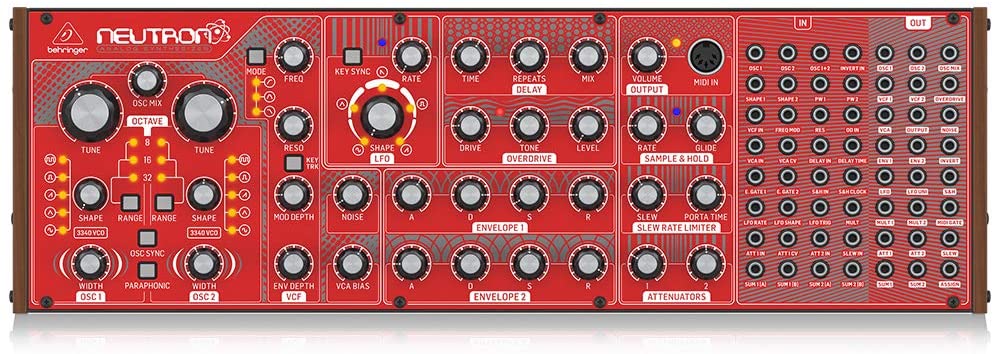
A small trip down memory lane: the ’70s and ’80s saw the birth of expensive and somewhat temperamental, portable analog synthesizers, which were quickly adopted by musical artists such as Jean-Michel Jarre, Jan Hammer, Isao Tomita, and Chick Corea.
Now, Behringer NEUTRON is an upgraded incarnation of its predecessors that packs all the original features and more. The instrument enables you to conjure up any monophonic sound with commendable finesse and ease. Its pure/clear analog signal path is based on reliable VCO, VCF, VCA, state variable filter designs, flexible, classic BBD (Bucket Brigade Delay), and multi-wave LFO.
Its paraphonic mode enables independent control of the two 3340 analog oscillators. That, in turn, expands the palette of sound options. What’s more? The instrument is mountable in a standard Eurorack for protection and convenience. As such, NEUTRON is ideal for road or studio sound design explorations.
The model benefits from its semi-modular format, which provides an intuitively linear workflow. Besides, it requires no patching for right-away performance. You only need to put the instrument into self-oscillation, connect your computer or keyboard via MIDI over USB or DIN, and start your sonic exploration immediately out-of-the-box.
Other features: multi-pattern triple-layer sequencer; comprehensive modulation matrix; 16 pads; The Brute Factor; filter with Low Pass, High Pass, Band Pass, and Notch modes; 2 LFOs supplying 6 waveforms
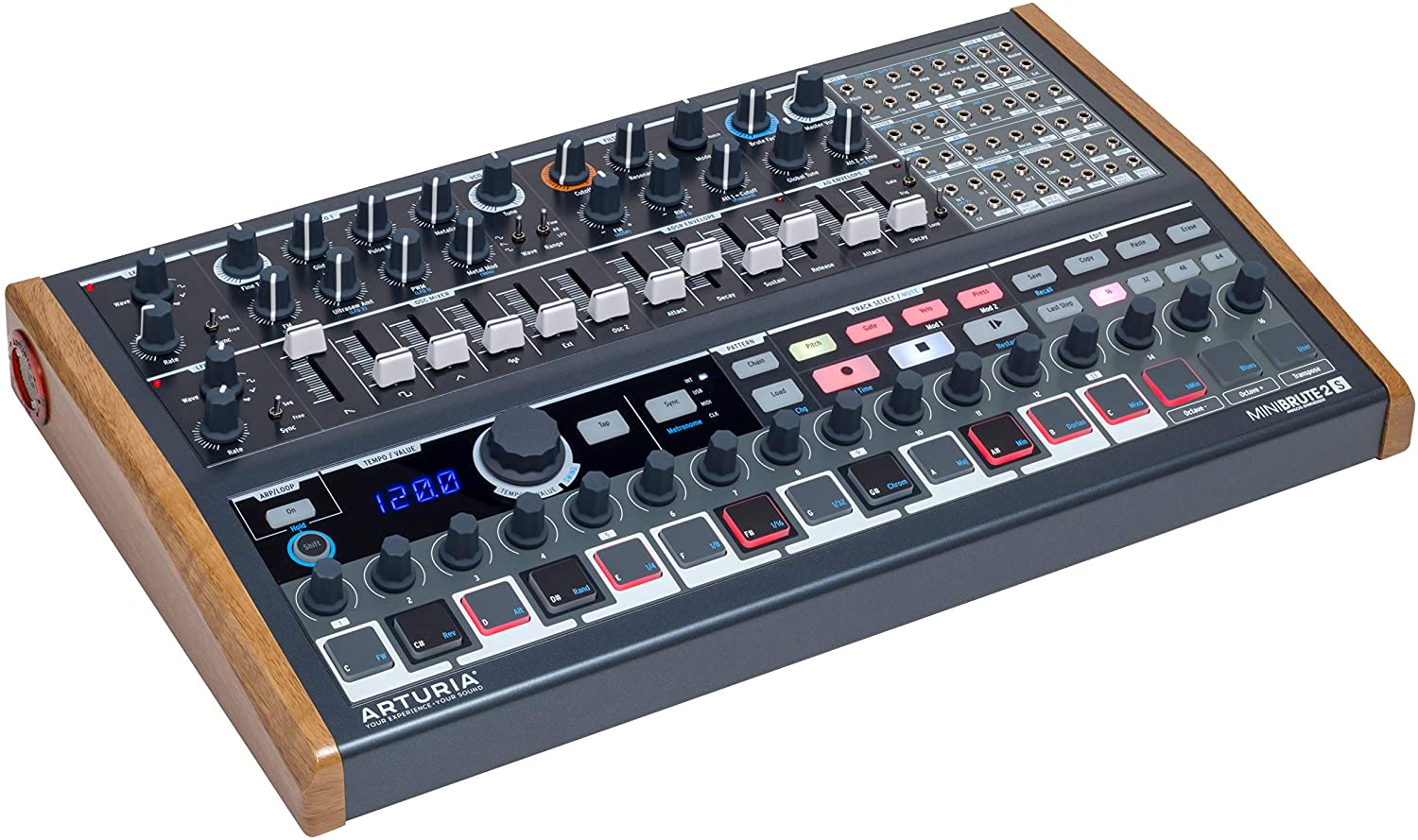
This Arturia MiniBrute 2S has a compact row of velocity/pressure-sensitive pads in place of a keybed to deliver massive sound that’s addable to your synth setup with ease and finesse. Being semi-modular, the MiniBrute requires no patching for immediate performance. Tapping into its 48-point CV modulation matrix provides endless creative possibilities.
Its three-layer BeatStep style sequencer enables you to sequence single notes and associated progressions on one layer while sequencing parameter changes on the other layers. As such, the instrument can create two-tone polyphony.
Other features: Hardware Spring Reverb; analog ADSR envelope generator; 4-Pole 10Hz-20kHz Ladder filter; Patchable 1-Pole High Pass filter; 2 analog oscillators; compatible with DFAM, Eurorack modular systems, and more
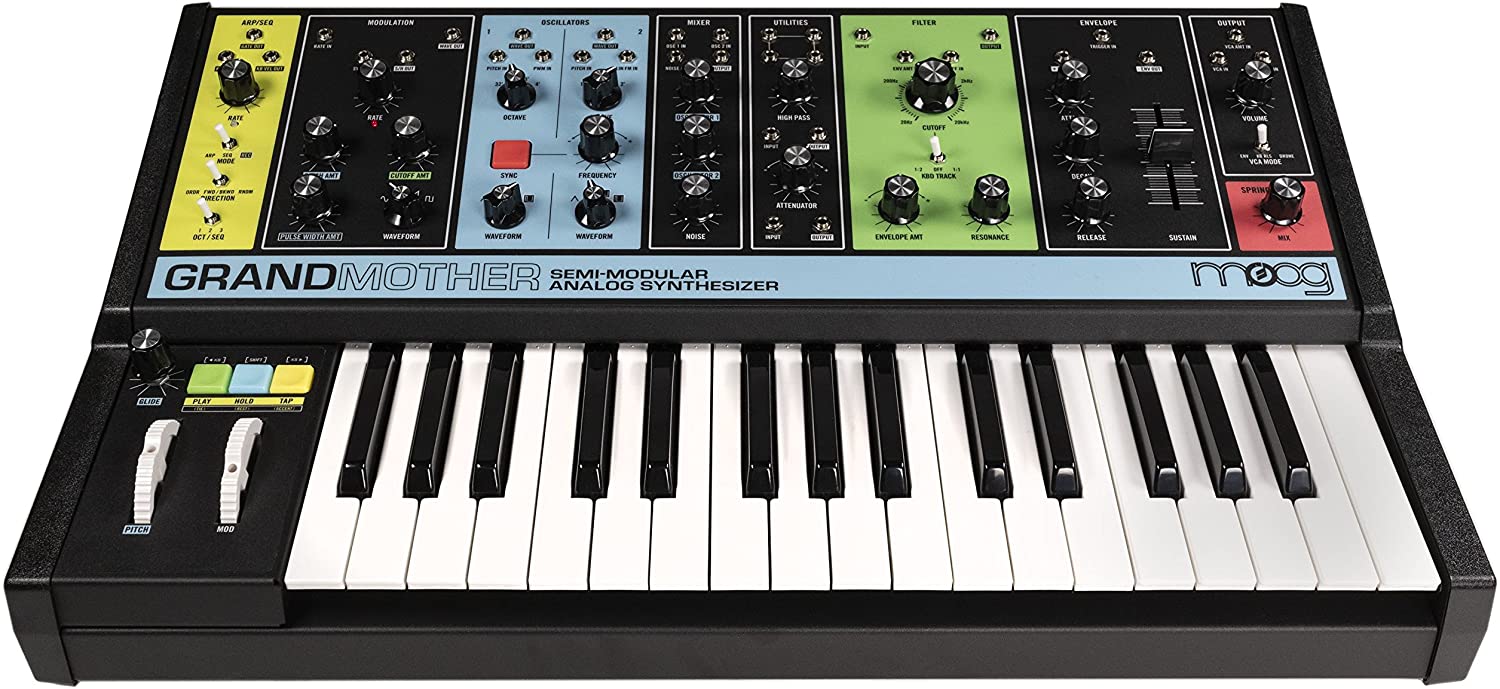
Moog Grandmother is a semi-modular analog synth that packs a spring reverb tank, sequencer, and arpeggiator.
You know the drill; any semi-modular synthesizer requires no patching for immediate sonic exploration. With it, any artist (regardless of their skill level) can effortlessly explore, discover, and enjoy the magic of analog synthesis. But unlike other semi-modular synths, Grandmother has an endlessly reconfigurable front panel for extending DFAM, Mother-32, or Eurorack modular system. Its circuits, spirit, and spring reverb are inspired by the Moog Modular Synthesizers. As such, Grandmother is an incredible addition to a DFAM, Mother-32, or Eurorack modular system.
Like most grandmas, Grandmother sticks to Moog’s culture, as seen in its depth in Moog’s modular roots. Here, synthesis is about more than results. It encompasses the journey of experimentation, discovery, and mastery.
Inspired by its predecessor, Grandmother’s spring reverb tank, modulation engine, and sound engine are entirely analog. As such, there’s no restriction in the sonic definition of immeasurable power and beauty. Added to that is a simple-to-use sequencer and arpeggiator for programmable syncopation and added enjoyment.
Furthermore, Grandmother is a stand-alone function and a suitable analog audio processor, especially for external sound sources.
Other features: voltage-controlled oscillator; VCO mixer; external signal processor; self-oscillating high-pass/low-pass filters; flexible patching system; envelope generators
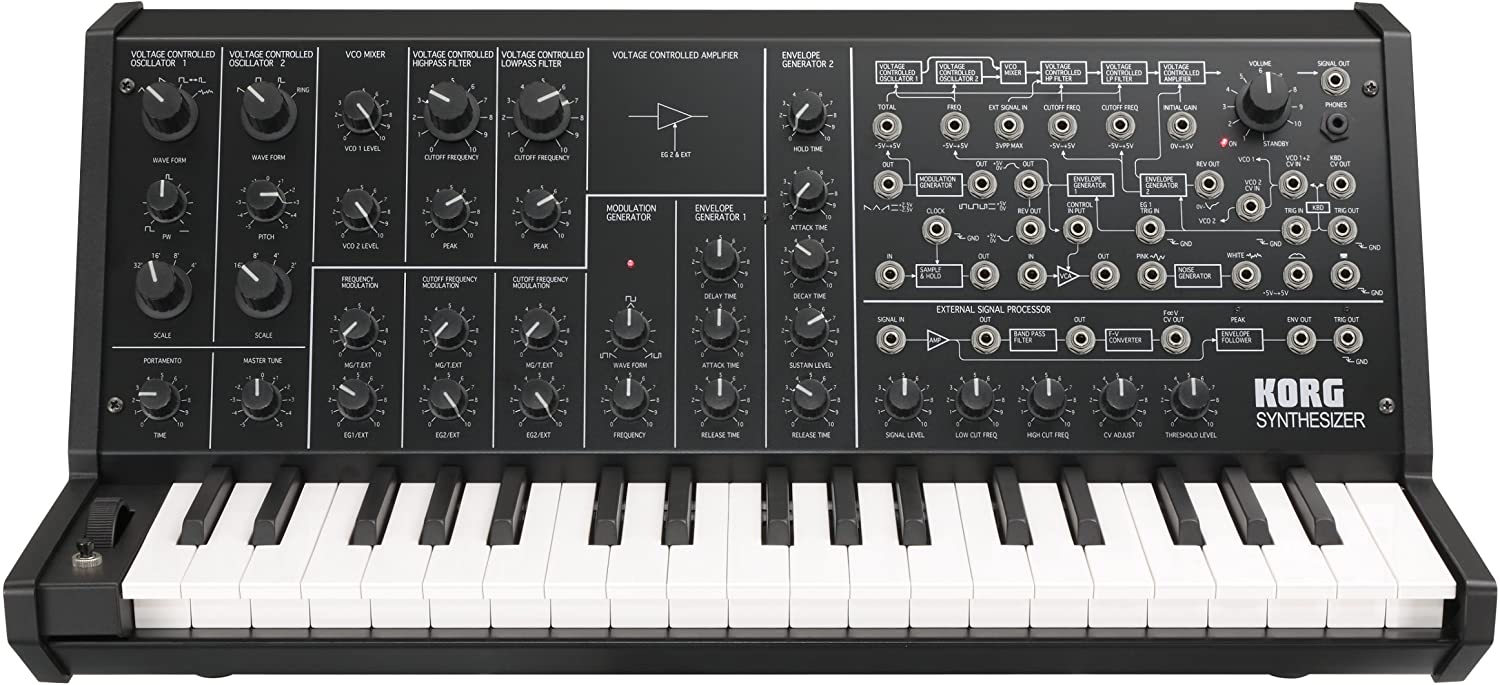
Korg MS20 Mini is a semi-modular analog monophonic synth that boasts the classic tone of the inimitable MS20. It’s a replica of the original MS20, only that it’s 86% of the original size.
MS20 Mini amazes with its authentic sound, fat and juicy basses, plus gripping lead tones. It also boasts warm strings and pads.
The model packs 2 oscillator synth with 2 VCAs, 2 VCFs, a noise generator, sample and hold, as well as extra tweakable components. The voltage-controlled oscillator generates all sound for this model, while the self-oscillating low-pass/high-pass filters produce distinctive distortions.
Its flexible patching system eases its extendibility, while the USB MIDI plus 5-pin MIDI creates more room for unlocking the potential of the MS20 Mini. At the same time, the included external signal processor (ESP) makes it a suitable analog audio processor for external sound sources.
Other features: six-tone subharmonic chords; selectable quantization; Self-Oscillating Ladder Filter; 17 input jacks; 15 output jacks; Eurorack-compatible
The Moog Subharmonicon is a versatile analog synth of subharmonically derived sound and synthesis. It’s the go-to modular labyrinth for when you want to lose yourself or find yourself.
Subharmonic is simple to use yet able to produce complex patterns and sounds. With 4x Subharmonic Oscillators, 2x VCOs, 4x Rhythm Generators, and 2x 4-Step Sequencers, the instrument generates a rich harmonic kaleidoscope that self-subdivides until everything is in harmony.
It’s a semi-modular polyrhythmic analog synthesizer engineered for sonic exploration. Its sequences evolve and unfold over time, spiraling via 6-tone subharmonic organic polyrhythms and chords and organic polyrhythms.
Moog Subharmonicon has a unique approach to sound design, an approach inspired by experimental music that sprawled out around the ’30s and ’40s, plus innovative ideas on electronic or modular instruments. The said approach combined math and music to form an Avant-algorithmic concept, which laid a foundation for today’s exploratory practices.
Thus far, we have discussed our preferred manufacturers and their top-pick module functions. In this section, we’ll guide you on how to narrow down from eight synthesizers to one. For this buying guide to be effective, fixate on what you want your modular synth to do and how to integrate it with your current setup (if present). Then keep the identified needs in mind as you scan through the following factors.
Invented in 1950s, the modular synth is that mass of cables and flashing lights you saw in a studio or a friend’s desk and wondered how the amalgamation qualified as a musical instrument!
Technically, a modular synth is a music or sound-design instrument that’s made from different modules. The main types of modules are voltage control amplifier (VCA), voltage control filter (VCF), voltage control oscillator (VCO), envelope, effects, LFO, and utility modules. These modules are either digital or analog (controlled by voltage).
The modules are connected with wires, with the standard patching being VCO -> VCF -> VCA. The connecting cables are always mono and can be big jacks, banana, or small in size.
Purpose-wise, a modular synth (synthesizer) gives a unique ability to make personalized sounds.
So versatile are these synths that you can make sound with one instrument’s oscillator and the filter or clone of another device – from a different brand! And yes, you can use the synth to compose an entire soundtrack or album without a DAW (Digital Audio Workstation).
As stated above, modular synths comprise different interchangeable modules. Each synth element can be physically and visibly separated into distinct modules, which perform specific roles. The modules are synonymous with organs in a human body; the connected modules work together (in harmony) to produce a sound. And just like organs are connected with veins, arteries, and whatnot, these modules are patched together with wires (patch cables). As such, the functionality of a synthesizer is based on this interconnectivity.
Here’s a breakdown of the signal flow of a synth patch.
Control voltage is how modules in a synth communicate with each other. And since communication controls a system (to a greater extent), parts of the modular synth are voltage controlled. So, we talk of a voltage-controlled oscillator (VCO), voltage-controlled amplifier (VCA), and so on.
CV is a continuous signal, not a series of discrete messages. And it’s not distinctive from the generated sound signals. Therefore, you can patch the output of a VCO into the input of a VCF without compromising the quality of your sound.
Note, patching CV signals straight into an output can prove harmful to your speakers!
The voltage-controlled oscillator is the heart of a modular synth, giving it its characteristic timbre and sound. VCOs come in varying complexities and styles, but some things remain the same.
For instance, a VCO pitch is controlled by a volt per octave (V/oct) protocol. The signal (instruction) from different modules is sent (via CV) to the VCO to dictate the oscillator’s frequency. As such, a specific musical note is created.
Another common type of oscillator is the LFO, which is similar to VCO in all aspects except the rate of sound output.
Filters serve to shape the sound by removing undesired frequencies. They can also boost specific frequencies as need be.
Filters are often high-pass or low-pass. The latter removes high frequencies from the VCO, while high-pass filters remove low frequencies from the VCO.
Filters also boast a resonance feature that emphasizes the cutoff frequency or center frequency of the filter.
The EG controls the volume of the amplifier often through four parameters:
Each of the parameters is a stage that determines the time it will take the VCO’s signal to reach peak volume, secondary volume, and zero volume – once the note is released.
ADSR EGs are the most common for this function; however, there’re more options.
Besides controlling the volume of a VCA, an EG also modulates the cutoff/center frequency of the VCA (filter).
Interestingly, the envelope generator can be used to control the oscillator pitch. That’s how versatile the modular synth is.
An amplifier controls the volume of the oscillator through a control voltage or a knob.
Often, amplifiers are used to gate the oscillator – they help to start or stop a sound easily. Amplifier-based modules are small and usually include more than one VCA.
You can think of the sequencer as the brain of a modular synth. It dictates the musical notes by providing gate and pitch signals to be patched to the envelope, oscillator, etc.
Sequencers come in varying sizes and shapes but often playback a predetermined series of musical notes to create chords, basslines, or melodies.
You can use a MIDI module in place of a sequencer. The only difference is, a MIDI module takes notes from eternal DAW or keyboard and converts them into gate or pitch control voltages.
An output module helps to lower the hot modular level. Yes, modular is loud, louder than line level. And the output module controls volume for the entire modular system.
The difference is, semi-modular has a hard-wired signal path. As such, you can use the synth for sonic exploration immediately without patching. At the same time, you can alter the signal path via patching to fully unlock the synth’s potential. Examples of semi-modular synths in our list are Korg MS20 Mini, Moog Mother-32, and Moog Grandmother.
On their end, fully modular synths require patching before use. Modular synthesizers come in two variations. One, you have cases or cabinets where you can put panels or modules. This model is versatile, as models can be removed or added as need be.
The other category is a stand-alone instrument comprising all the necessary components required in sound and music design. This model is more portable.
Both types of synthesizers have their merits and limitations. As such, the choice between modular and semi-modular synths depends on your preference.
If you want to make some infinite melodies successfully, break out of the box, or settle for a relatively affordable fixe architecture hardware synth, consider the following.
A synth can either be digital or analog. A digital synth employs DSP (digital signal processing) to create sound, while an analog synth uses analog signals and circuits to manipulate electric voltages – to produce sound ultimately. Although some people believe that analog synths yield more ‘warmer’ ‘thicker’ sounds, both types make quality sounds. Typically, analog models are pricier, but their relative ease of use counters that.
All the synths in our list are analog decent, so let’s dive further into the analog structure.
Analog synths are associated with subtractive synthesis, with clear labels and controls for oscillators, filters, amplifiers, and envelopes.
So, when purchasing, you need to review the following components:
And select their respective properties that fit your needs.
When it comes to power supply or cases, considers their measurements as denoted by U (height of the module) and HP (width of the module).
Eurorack modules are the most common (thanks to their accessibility and affordability) and are all 3U (5.25 inches) in size. Thus, a case that’s 6U denotes a Eurorack two rows, 9U a Eurorack that’s three rows, and so on.
Note, there’re other cases with a 4U or 5U format, like in Moog synthesizers. Such cases can house larger cable sizes – think of ¼ inch wire. Here’ the breakdown:
As a rule of thumb, the larger the case, the more modules you can host. And the more the modules, the more sonic exploration possibilities. So, go for at least 6U 84HP or 6U 104HP cases.
With the case at hand, consider the type of modules that will meet your needs. Do you settle for an LFO or VCO as the sound source? If it’s the VCO, do you go for one or two or even three per setup? At the same time, will it be a simple analog oscillator or a complex analog oscillator? Consider every aspect of every module you want to include in your modular ecosystem.
Here are sample structures to act as a guide:
Modular rigs fixate on paraphonic and monophonic synthesis.
A monophonic synthesizer can only play a single note at a time. Yes, such a synth can have multiple oscillators that can be tuned separately. However, they’ll all be triggered when you press a key. For example, Moog Grandmother and Korg MS20 Mini.
A paraphonic synthesizer can play more notes at a time but is limited to one voice structure. That is, every note produced goes through the same VCA envelope. So, you cannot play and trigger different notes at the same time. An example here is the Behringer NEUTRON.
As noted earlier, the sequencer is the heart or brain of the entire modular system. It can be a gate sequencer, CV sequencer, or both CV and gate sequencer. In more details, sequencers are grouped as:
Cheap sequencers are limited in functions. They cannot save patterns or change the pattern when it’s playing. They are fun when connected to an advanced modular system, but you’re likely to outgrow them fast.
Arturia dominates the mid-range position. Their Keystep, Beatstep, and Whatnot are desirable by modular enthusiasts. Such sequencers can provide:
They are compact and ideal for live performance
High-end sequencers, on their end, replace your computer as the beating heart/brain of your modular ecosystem. These sequencers are somewhat pricey with a steep learning curve.
The structure of your modular system dictates the connectivity. For instance, your case’s height will determine the size of connecting cables that can be housed.
The power supply/case size also dictates the number of modules to be housed in the case. The cable sizes and the number of modules, in turn, dictates the system connectivity.
The extendibility of a modular synth is determined by the number of patch points – and the higher the number, the better. You can also enhance the extendibility of your synth with a Eurorack module.
Some synths like Moog Grandmother feature an endlessly reconfigurable front panel that can help extend other instruments like Moog Mother-32.
The available studio space dictates the dimension of your ideal modular synth. A compact synth, for instance, is suitable for limited studio space. It is also available for use anytime – since you won’t have to pack it away to create extra space when not in use.
If you want to make music outside your home, go for a portable option. That means a compact and lightweight model.
Most manufacturers make analog synth modules (filters, envelope generators, oscillators, etc.) in the Eurorack format.
You can also consider adding a filter, mixer, and output module.
Now, no one is against being spoiled for choice. However, an extensive array of options can make it hard to find the best modular synth for your needs. And though worthwhile, it can be time-consuming to research and experiment on different models. Luckily, we did all that for you, and our vote goes to the Moog Matriarch. Why?
We loved that with Moog Matriarch, it’s easy to get creative and generate innovative sounds. It provides endless sonic possibilities making it the master of your modular synth rig.
If looking for a more affordable instrument, settle for Korg Volca Modular. This synth produces different and exciting (drum-like and non-drum-like) sounds, thanks to its waveguide effect and sound design controls. It also provides pattern-linking, real-time recording, part muting, and per-step accents. Furthermore, the modular is compact, enabling you to create sounds just about anywhere.
Alternatively, settle for our third-best model – Moog Mother-32. It produces fantastic sounds with a versatility that suits both novice synthesists and the more neurotic and adventurous musicians. Its sequencer is tons of fun, while its MIDI works excellently. Moreover, it features those classic Moog sounds, which makes it one of the best semi-modular synths.